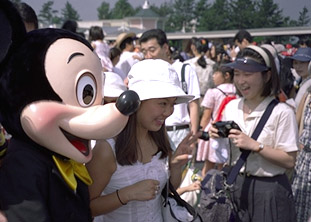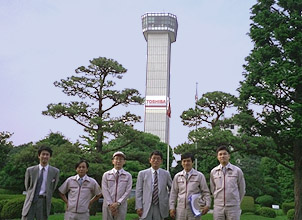
Bruce "Tog" Tognazzini.
|
Japan on $1000 per Day
Day 5: Mice, Aircraft, and ElevatorsDay 5: Julie and I are off on separate adventures. My wife, the doctor, takes off for an all-day tour of Industrial Tokyo, visiting the JAL maintenance facility at Haneda Airport. There, they not only repair their own aircraft, but aircraft from other airlines around the world interested in taking advantage of the Japanese penchant for perfection in workmanship. She then visited an Isuzu engine plant, where she watched a constant stream of varying engines being assembled by workers, both warm-blooded and cold-siliconed. Julie noticed that no two engines in a row were ever the same. "Better for workers" was the guide’s reply. The Japanese, who are not exactly renown for their care and feeding of their workforce, have discovered that boredom, the hallmark of Western manufacturing for the last 100 years, seriously impacts productivity. They give the workers new tasks on each engine because it keeps them alert, happy, and productive. It is a lesson we are finally learning in our country, but it is seriously overdue. I, the engineer, headed out for Tokyo Disneyland, completing my world tour of Disneylands everywhere.
I noticed one major difference at Tokyo Disneyland: I saw not one of the myriad of street sweepers that rush around behind visitors at other parks, catching their discarded papers practically in mid-air. They don't need them. No one discards a thing. I did see one cigarette dropped to the ground and crushed out in the line winding toward the Pirates of the Carribean, but the smoker immediately picked up the resulting butt and held it in his hand until the line reached the trash can. The Japanese unwillingness to litter under the most trying circumstances has resulted in an ironic twist; because they are unwilling to litter, their government hasn't felt any pressure to provide litter baskets. We would walk for blocks in heavily-touristed areas with the twisted remains of snow-cones sagging in our sugar-slicked hands without a trashcan in sight. The most interesting "ride" at Disneyland was "Meet the World, " where you "Revolve on a carousel through time and relive Japan’s fascinating encounters with other cultures." The presentation began with an animated film showing Japan rising from the sea, aboil with volcanoes. As the volcanoes cooled, the land began to look more and more like cold gray stone, and the seas began to look suspiciously like small pebbly sand. When the camera moved back, we discovered we were now looking at a chain of rocks, perhaps 8 feet long, poking up through a sandy beach. Beside the rocks were two terminally-cute looking Japanese kids who took to wonderin’ exactly how Japan’s history had all taken place. Fortunately, on this very same beach was one of Japan’s most famous birds, the crane, who also happened to be an historian by vocation, and a public speaker by avocation. The crane allowed as how he would love to take the two kids on a tour of Japan’s historical encounters with the outside world, and, by golly, he invited us along, too. The history was shown through a series of audio-animatronic tableaus, carrying us forward from Japan’s first contact with the Chinese. We arrived at 1854, when Commodore Perry showed up with the American fleet and threatened to blow the Japanese to kingdom come if they didn’t open up trade with us. This was "Disneyized" by having the first mate say to Perry, "Why don’t we lob a couple shells into the midst of this mob and shake them up a little." (That was the gist of what he said.) The great American admiral, however, replied, "We shall not fire, for we come in peace only to open trade between our two great nations" or some such drivel. The narrating crane then "Japanized" history by explaining to the little children why the Japanese acquiesced: "The samurai were mighty warriors, but even they were no match for the march of time." As this tableau faded, we returned to the film, but now it appeared to be night time on the beach. We could hear the cold winds blow for several seconds, afterwhich the shivering little girl suggested to the crane, "it is dark." The crane replied, "Yes, but soon it will grow light again," afterwhich indeed, the beach lit up as it had been before. Thus was covered, in depth, the adventures of World War II and the loss of some 60 million lives. ToshibaAfter a delicious bento lunch at Restaurant Kokusai on Main Street, I was back on the train and off to Toshiba Fuchu Works, the top-secret base of Toshiba elevators, funiculars, and software.
The people involved in software quality control, like other Japanese workers, either wear suits if they are sufficiently exhalted salarymen, or uniforms. The company uniform is worn with with great pride, as loyalty to company is all but as strong as loyalty to country. (Contrast that with Silicon Valley, where employees who linger at a single company for more than five years are treated with suspicion.) Japanese business meetings follow a set formula. Seating around the table is done strictly by pecking order. Speakers present according to the same pecking order. Formality is all, no argument occurs, and no decisions are reached. As the meeting wore on, with each Toshiba person in turn telling me of their job and its effect on quality, I noticed one of the senior Toshiba people slip off to sleep. I was overjoyed to see this. I had read in my book on Japanese etiquette that this happens frequently, and I had been hoping to witness it. This does not arise out of impoliteness, but, rather, out of compromise. The decision as to who attends a meeting is based purely on the importance of the visitor, not the needs of the meeting. As a result, high-level managers are often attending meetings that are completely irrelevant to their jobs and their interests. However, they must attend. The compromise is that they need not remain awake. Toshiba’s software development process at first glance did not seem appreciably different from our process in America. They have a series of defined steps, such as research, specification, general design, detail design, coding, etc., that are not particularly different from ours (although many developers put coding first). When we dove a little deeper, though, the real difference showed up. Between each step, they have design reviews. So do we, but they call these interstitial spaces "hold points." We used to have "hold points" in America. NASA used them until shortly before the Challenger disaster, by which time our hold points had become more like "talk about it, then go ahead anyway" points. Never have I heard this term applied to software. If these people find out they have a problem, they actually stop and fix the problem! How marvellous! How refreshing! How weird! Please read about how the Japanese view quality in the Attitude of Quality sidebar. Then join me next month as I sing for my supper--live, squirming food. Strictly fresh. Previously: Day 4: Magic Toilets & Poisonous FishNext: Day 6: Squirming Shrimp & Karaoki |

